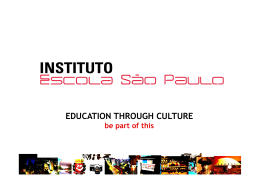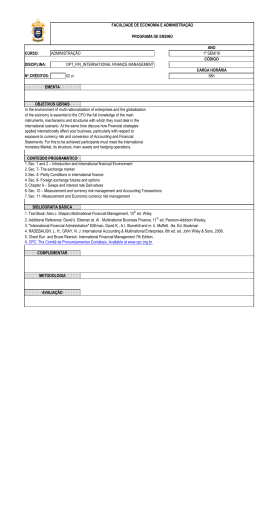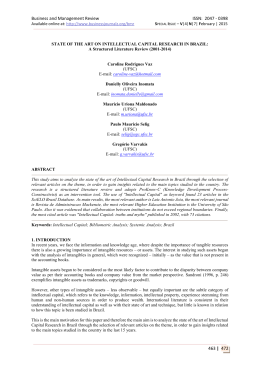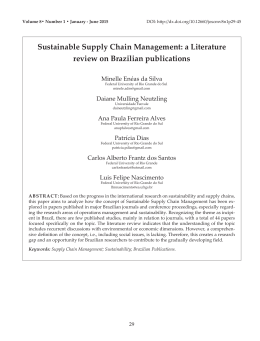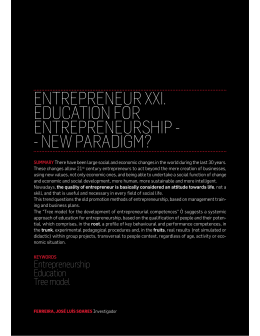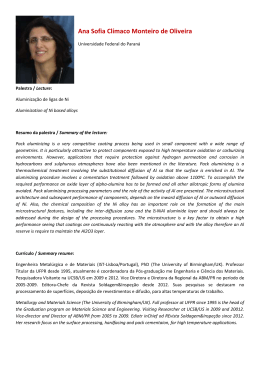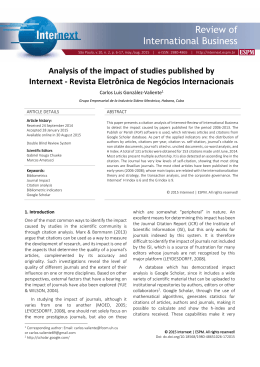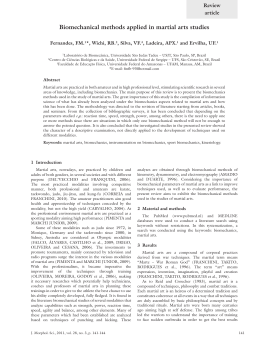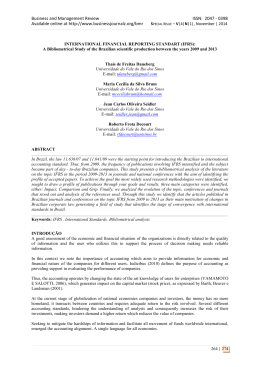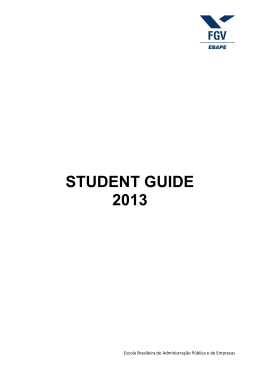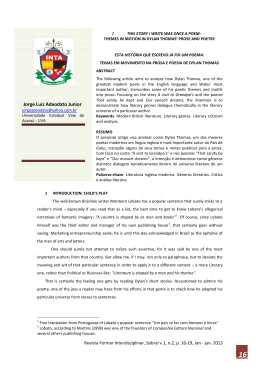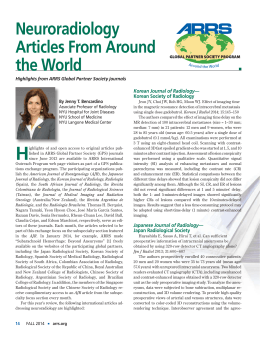Challenges of Corporate University Implementation and Management Tamara ALMEIDA Universidade Federal Fluminense Niterói, Rio de Janeiro, Brazil [email protected] Ariel LEVY Universidade Federal Fluminense Niterói, Rio de Janeiro, Brazil [email protected] ABSTRACT This study rise up the implementation process of a corporate university and uses the concepts of competency system, knowledge management, knowledge retention and strategy to structure possible models and tendencies related to organizational development based on internal knowledge creation. Establishes the connection between academic and private research and how they can act cooperatively. Keywords: corporate university, knowledge management, competency, strategy 1. INTRODUCTION The concept and application of a corporate university presents the relevance and challenges showed in the implementation scenario to obtain a better dynamism based on goals strategically addressed, differing from regular training to competency development training. Also, it shows how can the knowledge be shared and which tools can support this process. Companies through their objectives are actually more aligned on creating and obtaining internal knowledge and that’s why they have been giving special attentions to people management and organizational development. This study discusses the concept and application of a corporate university, for which it presents the origins and concepts, as well as, the relevance and challenges of the implementation scenario. It also addresses the goals and the utilization of people management techniques in modern organizations. The analysis is extended to the practical development of training, and management resource allocation systems. In the professional field, the study contributes to the analysis of the trajectory of developments in human resource management aiming on talent development. capital to the collaborators; i.e. as a strategic way to add value to the business [9]. In the social field, we observe that the reality of a corporate university is not inherent in everyday life of most employees of organizations. Research shows that while the processes of attraction and retention by raising the compensation are considered easier, the development is where the greatest dissatisfaction, which gives a fair motivation for continuous learning necessary for the evolution of organizations [9]. Regarding methodology, the study is defined as descriptive and explanatory. Descriptive, since there are exposed features and definitions of Corporate University as well as concepts that support this practice. Explanatory, by demystifying the subject while exploiting its advantages and disadvantages and the processes that compose it [35]. 2. CORPORATE UNIVERSITY - STRATEGIC RATIONALE, ORIGINS AND EVOLUTION Despite the early approach to the concept of competence in the United States in 1970, was from the 90’s that it expanded rapidly to support evaluation processes and guide actions on professional development. This begins an better understanding of the relationship between organization, people and competences and the ability to use those concepts as a parameter for the construction of new management tools [21]. As each individual that presents their own competences, which can be exploited to further broaden potential demand for competences, but not only those already identified in the required scope of the function as in figure 1 (below), as illustrated by Retour [27] Thus, the idea of position or function was replaced by the individual.. Figure 1 – The four levels of individual competences A quick analysis of the competitive environment on the labor market, could give the idea that companies would be comfortable about the prospects of training in personnel selection. The professionals, though qualified, normally do not conform to the demands skills in organizations [24]. Also, the turnover presented on management level impact on routine business. Companies facing this context seek and manage their intellectual assets in order to achieve sustainable competitive advantages, as well as retain its intellectual property [26]. This leads to the scenario, where companies need to invest in the workforce, aiming to meet their demands of current and future human resources [19]. The corporate university emerges as a path under the hypothesis that by following a superior dynamism on academic development, which complements the education obtained on regular institutions [26], inclusive as a way to recognize and drive recognition of the pertaining abilities and the intellectual Souce: [27] According to Retour [27], the required competences are those demanded by the office. However, the individual can mobilize more expertise than the demand. Some required competences are not applied by the individual for not having yet the preparation or suitability for any reason. Thus, the competences detained are those owned by individuals but not yet explored, because of the lack of an opportunity or a propitious environment. And finally, the potential competences are those that the individual can acquire, by being trained or prepared, and can detain them. The concept of competence is revealed as a set of human capacities (knowledge, skills and attitudes) that justify a high performance, believing that the best performances are based on intelligence and personality [14]. This can be translated as a "stock of resources ", equivalent to the capacity detained, which increases the potential capacity in the context presented in Figure 1. Strategic Rationale The competence, to be transmitted through the practice is impossible or difficult to copy, its creation is unique by individuals with training and practice which determine the addition and expansion of their competences. Borges [4] follows Sveiby [33] and highlight, the role of expertise within organizations, as a link between knowledge and strategy, as the ability to act with respect to other organizations. In successful organizations, values, ideas and practices that contributed to success became part of the institution. A learning organization is characterized by strong organizational culture, incentive for change and adaptation. As part of the organizational learning process many companies try to emphasize equality, cultural values, seize opportunities and adaptability to meet crises and still remain competitive in a volatile environment. To illustrate this relationship between individual skills transformed into organizational competencies through learning and further developed to meet corporate strategies, is exhibited in Figure 2 (below) the cycle of transformation and coexistence of these factors in the learning process organizational alignment of the strategies and competences [15]. Figure 2 – The cycle of transformation and coexistence Source: [15] The development of core competencies to the business, the presence of unrestricted educational services to employees, and partnerships with institutions of higher education and degree granting independent are the characteristics that support the definition of Corporate University [3]. This proposal for corporate universities not only favors the formation of strategic development of core competencies to the business. But also, and concomitantly, the observation of two fundamental characteristics: Openness to the outside public in general, which favors the discovery and recruitment of talent, and partnerships with institutions of higher education, especially for the validation of credit courses and the possibility of degree granting, jointly or independently. Origins and Evolution The definition of Corporate University is directly linked to its application, and varies from organization to organization. Its format is set by the guidelines and requirements of each organization, although there are no models, parameter sets, or patterns that must be followed. One of the proposed definitions is that the Corporate Universities present themselves as responsible for the development process of people aligned with business strategies and core competencies of the organization [2]. They can also be understood as a direct evolution of the function or process of training and development [26]. It is important while defining Corporate Universities, to raise their differences to training and development departments. While training and development departments tend to follow a demand for qualifications, and identified an immediate requirement is attended by the departments of Training and Development (T & D), in response to requests that are submitted by users. A Corporate University's principle is the advance preparation of skills and competencies that will become necessary to meet future business strategies of the company. They differ from the usual training and development centers for its agility and proactive adjustment to the business environment in which they are embedded. The focus is primarily on strategic development of core competences, and envisions transforming the education of employees who hold the corporate knowledge into competitive advantage [2]. Therefore, the departments of training and development are intended for more technical skills directly related to the immediate requirement for a certain task, unlike the Corporate Universities that incorporate into their programs and involvement in the culture, values, mission and goals of the sponsoring organizations, tied to the position of the market and business vision [19] [3]. The Corporate University has its first appearance in the mold of today with the creation of Crotonville Management Development Institute of General Electric in 1955. However, it was in 1980 that the concept has spread by large U.S. companies [26]. In the U.S. they increased significantly, ranging from hightech industries to financial services [10]. Their format has changed considerably today, no longer as a physical location for classes, as in the recent past, but as a process concerning the strategic management of knowledge [19] [26]. The current format of the Corporate University lost the definition of physical place to become a strategic management process and, therefore, through the widespread use of systems for distance learning, their design is no longer in shape to student / teacher ratio in classrooms, especially in the virtual environment [19]. This evolutionary transformation starts from a choice of environments and systems for managing distance learning internet courses that are available on the market for those responsible for training interested in inserting a solution of distance education in their organizations. While these options may be differentiated by particular details, the solutions have converged to the same technology, the Internet. With the backdrop of virtual learning environments, which provide flexibility of time, place, content and form of instruction have not yet seen. The Internet also enables for students potentially qualified for the learning of what they need, when and where they determine as well as the format and pace most appropriate [16]. Distance learning and e-learning in Corporate Universities have an important role in providing the opportunity in order to accelerate learning [19]. By using technological tools, learning became not restricted to the model "classroom-teacher-student" and offer different learning systems as case studies, business valuation, benchmarking functions, supplementary readings, and virtual communities. What draws more attention to this method is the short term, low cost, developing competitive advantages in improving skills. [18]. The increase in courses offered by distance learning via the Internet is pushed by the difficulty created by factors such as high cost of traditional education, dynamic change in course content, temporal order constraints such as time zones and different working hours, geographic limitations, motor restlessness of students most distant and development of interactive communication technologies[16]. 3. THE CHALLENGES OF CORPORATE UNIVERSITIES By setting the intention to develop a Corporate University or a Corporate Education System is important to identify the steps in this process and challenges encountered, identifying them in a descriptive and comparative way. To create a system based on the strategic plan it is essential to comply with items such as engagement of senior management, and strategic alignment model of people management with business strategies. Another factor is the investment required for the operation of a corporate university. The institution of the process, facilitation of intellectual and material resources necessary for its development are quite significant and difficult to measure results, which may explain why they are most easily found in large organizations, with a more solid financial structure and more analysis tools for investments [3]. Among the intangible assets necessary to model the learning process, through the absorption of knowledge for learning to learn, are the methodological guidance in the preparation of courses, the sensitivity of teachers and tutors to make the process a learning activity to be extended out the organization, as an exercise in life. For this purpose, it is necessary to develop a creative environment, propitious to sharing experiences among those involved in the process. With the objective, of building learning communities, involving academic theories and practice of the corporate world [18]. There are other challenges in substantial changes on internal structures of the development of people with the proposal of Corporate Universities such as: Empowering people to compete in a globalized economy; The development of mental models and behavior toward continuous learning and adaptation to environments subjected the frequent change; Training to lead organizations in international contexts, with strong cultural diversity present in everyday business and the people who work there; Preparation for constant acquisitions and merger, the reconciliation of people and the prospects of the company, so as to reach both the interests at stake in the educational process and those that are fundamental to the success of its implementation; And finally, the encouragement of self-development of employees, which implies strong changes in the company's culture of learning [9]. In a study of best practices for implementation and growth of Corporate Universities [10], were found six critical factors for the creation and growth of such an initiative. The first is the commitment of the governing body of the company, appointed previously as crucial for the success of the project, engagement of senior managers of hierarchical levels. The second is to have well defined its purview, i.e.: What is the scope? For what it will be responsible? The third is to define which the targets audiences are, and what are the range of products and services that will be offered to them. The next factor is determining your educational partnerships and technology to be implemented. The following factor would be the development of appropriate tools of metrics on possible economic advantages offered by the corporate university. Finally the sixth factor was identified as the creation of a marketing strategy and communications for the university. 4. FINAL CONSIDERATIONS Analyzing the evolution of strategic thinking, there is a transition through different phases and semantic contexts. Since its ancient origins, the word strategy has taken different meanings, without however losing its semantic root. Today in organizational and business context, a strategic plan represents an important instrument of adaptation to a turbulent and competitive market, which requires the preparation of the organization to compete. Thus, the organization must provide itself with the unique competences that result in competitive advantage. One way to achieve this is through training of internal resources in a systematic and objective way. The suitability of the most dynamic models, knowledgeoriented, based on adaptation and response, is needed to achieve the capacity to innovate and plan this new context [6]. Universities have to build the link homogenization of values, cultures among customers, suppliers, shareholders and society as a competitive and is using the approach of potential competencies in corporate education, exploratory purposes with the skills to be developed, which is based the structure of a Corporate University [4]. By setting goals with strategies for developing a detailed action program that allows to reach them, the company should therefore seek leadership in this case the insertion of a corporate university and corporate education [17]. When choosing a model that could represent the inclusion of a corporate university in a dynamic context, the McKinsey 7-S seems appropriate. The model assumes that an organization is not just a single structure but consists of seven elements: Structure, System, Style, Staff, Skills, Strategies, all interacting and converging to the element Shared Values depicted in Figure 3[8]. Figure 3- McKinsey 7-S structure Source: [8] The seven elements are classified as being "hard" and "soft ", where "hard" are those defined as foundation of success involving structures, systems and strategy of an organization, shown in the figure above, in lighter color . Since the elements of "soft", are presented as complementary elements of success for Style, Staff, Skills and Shared Values, highlighted in color stronger [8][17]. The "hard" elements can be found in statements of strategy plans, organizational charts and other similar types of documentation and registration. But "soft" are not so perceived, and are difficult to describe since capabilities, values and elements of organizational culture are in constant evolution. In fact, the "soft" elements are largely determined by individuals working in the organization. Thus, it is much more difficult to plan and influence the "soft" elements, although such elements have a major impact on "hard" elements of an organization, reaffirming the centrality of the human factor in strategic development of business. Corporate Universities have as their main objective the creation of sustainable competitive advantage for the companies, and that its development behind a new approach to knowledge management and, therefore, a new path for organizations to manage their intangible assets. It is further understood as an evolution not only direct but also consistent to training and development function. A major difference between the corporate education and traditional education is provided by the focus on the development of values and culture in alignment with organizational strategies as a competitive advantage for the organization. It is mainly through the management of knowledge that the democratization process of tacit knowledge takes place, transforming it into explicit knowledge, which was also observed the reverse process to finalize the link in the knowledge spiral, as shown in figure 4 below [22]. organizations with more resources available for allocation in the development of corporate education [3]. Nevertheless the difficulties that covers issues of cost allocation, availability and orientation, there are also challenges in the management of intangible assets in this process, points that need to be closely watched in the decision of implementation and in the posterior moments when raising framework issues of individual participants of corporate education, and management purpose of creating a Corporate University [16]. Just as important as the involvement of the management, are the decisions about the timing and how to insert this structure into the organization. In part, this difficulty arises from the challenge of measuring the results and use of subjective concepts of learning in a company, which reaffirm the need for involvement of top management in order to develop the structure of learning in the organization. As well as indicating the tangibles and intangibles to be listed in the evaluation, which again raises the uniqueness of the presence of the Corporate University and formats for each organization. There are still many opportunities to continue in related research. For example the opportunities are: A research on the utilization of tangible and intangible people inserted in a program of organizational development: or a research on the occupation and relocation of individuals professionally trained in a corporate university; or a research to formalize ownership of business results, such as influence program, or even a research related to the development of metrics on specific topic of Corporate Education. Figure 5 – Challenges of research on implementation of a Corporate University Figure 4 - Knowledge Spiral Source: The authors Source: [22] As a strong trend in this process is the presence of distance learning, oriented to the use of tools like the Internet and information systems in their viability. This trend contributes to the vision of a corporate university as a process and not as a place or learning moment [19]. Not less important is the cost problem of adapting the company to the reality of a company that generates knowledge, and as a result of this difficulty we identify a greater presence of large These studies consist of projections of models and theories related to the theme that provide the practical adoption within organizations that face the challenges found in the implementation and management of a corporate university as illustrated above in Figure 5. Finally, by presenting clearly the objectives and outline the main challenges in the implementation and management of Corporate Universities, which excel for guidance in developing specific competences, this study contributes to a multi-pronged approach that recognizes the complexity and heterogeneity of human social practices, organizational and business. 5. REFERENCES [1] ABREU, A.; GONÇALVES, Caio Márcio; PAGNOZZI, Leila, “Tecnologia da Informação e Educação Corporativa: contribuições e desafios da modalidade de ensino-aprendizagem a distância no desenvolvimento de pessoas”,Rev. PEC, Curitiba, v.3, n.1, p.47-58, jul. 2002-jul. 2003. [2] ALPERSTEDT, C., “Universidades corporativas: discussão e proposta de uma definição.” Revista de Administração Contemporânea - RAC, Curitiba - PR, v. 5, n. 3, p. 149-165, 2001. [3] ALPERSTEDT, C. “Universidades corporativas: definição proposta.” Portal Universia, 27 mar. 2003. [4] BORGES, Maria Elisa Siqueira. “Trabalho e gestão de si: para além dos recursos humanos”. Cad. psicol. soc. trab., dez. 2004, vol.7, p.41-49. ISSN 1516-3717. [5 ] BRANDÃO, G. R. “Gestão de Pessoas e as Universidades Corporativas: dois lados da mesma moeda?”. RAE. Revista de Administração de Empresas, v. 46, p. 22-33, 2006. [6] DAFT, R. Organizações, Teoria e Projetos, São Paulo, ed. Pioneira Thompson Learning, 2002. [7] DAVENPORT, T.; PRUSAK, L. Working Knowledge, How Organizations Manage What They Know, Boston Harvard Business School Press, 1998. [8] DUTRA, A. ‘Metodologias para Avaliar o Desempenho Organizacional: Revisão e Proposta de uma Abordagem Multicritério” Revista Contemporânea de Contabilidade (UFSC), v. V. 1, n. n. 3, p. 25-56, 2005. [9] EBOLI, Marisa. P. “Gestão do Conhecimento como Vantagem Competitiva: O Surgimento das Universidades Corporativas”. In: Marisa Eboli. (Org.). Universidades Corporativas: Educação para as Empresas do Século XXI. 1a ed. São Paulo: Schmukler Editores Ltda., 1999, v. , p. 106121. [10] EBOLI, Marisa P. Educação Corporativa no Brasil Mitos e Verdades. Brasília: Ed. Gente, 2004. [11] EBOLI, Marisa. P. “O papel das lideranças no êxito de um Sistema de Educação Corporativa.” RAE. Revista de Administração de Empresas, São Paulo, v. 45, n. 4, p. 118122, 2005. [12] FLEURY, Afonso,“Aprende-se Com As Empresas Japonesas? Estudo Comparativo Entre Empresas Brasileiras e Mexicanas.” Revista de Administração ContemporâneaRAC, v. 2, n. 1, p. 7-21, 1998. [13] FLEURY, A.; FLEURY, M. T. L. Estratégias empresariais e formação de competências: um quebracabeças caleidoscópico da indústria brasileira.São Paulo: Atlas, 2000. [14] FLEURY, M. T. L.; FLEURY, A. C. C. “Construindo o Conceito de Competência.” Revista de Administração Contemporânea- RAC, 2001. [15]FLEURY, Afonso ; FLEURY, Maria Tereza Leme. “Alinhando Estratégias e Competências’’. Rae Revista de Administração de Empresas, v. 44, p. 44-57, 2004. [16] GHEDINE, T.; TESTA, Maurício Gregianin; FREITAS, Henrique, “Educação a Distância Via Internet em Grandes Empresas Brasileiras”. RAE. Revista de Administração de Empresas, v. 48, p. 2-10, 2008. [17] KOTLER, Philip. Administração de marketing: análise, planejamento, implementação e controle; trad. Ailton Bomfim Brandão; rev. técnica José Antonio Gullo.- 2 ed. - São Paulo: Atlas,1991. p.89 [18] MAIA, Marta de Campos. “Educação a Distância”. GV Executivo. Getúlio Vargas Executivo, v. 6, p. 56-60, 2007. [19] MEISTER, Jeanne. Educação Corporativa: A gestão do capital intelectual através das universidades corporativas. São Paulo: Makron, 1999. [20] MONTEIRO, N. A.; FALSARELLA, O.M. ‘ Um Modelo de Gestão da Informação para Aprendizagem Organizacional em Projetos Empresariais”. Perspectivas em Ciência da Informação, v. 12, p. 81-97, 2007. [21]NAKATA, L. E.; SOUSA, Edileusa Godói,”O conceito de competências e sua aplicação na gestão estratégica das empresas atuantes no Brasil”. In: XII Semead - Seminários em Administração, 2009, São Paulo. Anais do Semead Seminários em Administração, 2009. [22] NONAKA, Ikujiro,”The Knowledge-Creating Company”. Harvard Business Review, Florianópolis, July - August p. 162171, 2007. http://hbr.org, avaiable on 05/03/2010. [23]PADOVEZE, Clovis Luis; Controladoria Estratégica e Operacional: conceitos, estrutura, aplicação. São Paulo: Pioneira Thomsom Learning, 2005. [24] PAZETO, Antônio E.”Universidade, Formação e Mundo do Trabalho: superando a visão corporativa”. Ensaio. Avaliação e Políticas Públicas em Educação, Rio de Janeiro, v. 13, n. 49, p. 487-496, 2005 [25] PEREIRA BARTNIK, F. M.; PRIMI, R.; COBERO, C. “Validade de testes utilizados em seleção de pessoal segundo recrutadores”. Psicologia: Teoria e Pesquisa (UnB. Impresso), São Paulo, v. 5, n. 2, p. 83-98, 2003. [26] RAMOS, H. C.; OLIVEIRA, R. T. Q.; SANTOS, J. A. N.; ZOTES, L. P. “Transição de T&D para Universidade Corporativa”. In: IV Congresso Nacional de Excelência em Gestão, 2008, Niterói. Anais do IV CNEG. Rio de Janeiro: ABEPRO, 2008. v. 1. p. 1-15. [27] RETOUR, D.; THÉVENET, M. et al. Seminário Internacional “Gestão por Competências: Que Alternativas para a Gestão de Recursos Humanos? Uma Reflexão Internacional – Brasil – França”. São Paulo: FIA, Progep, 2005. [28] RUTHES, S.; CERETTA, P. S. “Abordagem sistêmica numa organização com produção do tipo job-shop personalizada: um estudo de caso”. Revista Eletrônica Sistema & Gestão, http://www.latec.uff.br/sg/are, v. 1, n. 1, p. 1-15, 2006. [29]TOFFLER, Alvin. A Terceira Onda. Rio de Janeiro: Editora Record. 1980, P. 18 [30] SALERNO, Mario Sergio. Da rotinização à flexibilização: ensaio sobre o pensamento crítico brasileiro de organização do trabalho. Gest. Prod., São Carlos, v. 11, n. 1, Apr. 2004. Available from<http://www.scielo.br/scielo.php?script=sci_arttext&pid=S 0104-530X2004000100003&lng=en&nrm=iso>. access on 03 June 2010. doi: 10.1590/S0104-530X2004000100003. [31] SANTOS, A. R. dos; PACHECO, F. F.; PEREIRA, H. J.; BASTOS JUNIOR, P. . “Gestão do conhecimento como modelo empresarial”. In: Antônio Raimundo dos Santos; Fernando Flávio Pacheco; Heitor José Pereira; Paulo Bastos Junior. (Org.). Gestão do conhecimento: uma experiência para o sucesso empresarial. 1a. ed. Curitiba: Paraná, 2001, v. 01, p. 11-48. [32] SILVA, Marco W.; BALZAN, Newton. C. “Universidade Corporativa: (Pré-) tendência do Ensino Superior ou ameaça?”. Avaliação (Campinas) , v. 12, p. 233-256, 2007. [33] SVEIBY, K.E. (1997) The New Organizational Wealth: Managing and Measuring Knowledge Based Assets, Berrett Koehler, San Francisco, CA. The chapter on measuring intangibles is available on-line: http://www.sveiby.com/articles/MeasureIntangibleAssets.html [34] VALENTIM, M. L. P. “Inteligência competitiva em organizações: dado, informação e conhecimento”. Datagramazero (Rio de Janeiro), Rio de Janeiro, v. 3, n. 4, p. 113, 2002. [35]VERGARA, Sylvia Constant. Projetos e Relatórios de Pesquisa em Administração. São Paulo: Atlas, 2003.
Download







